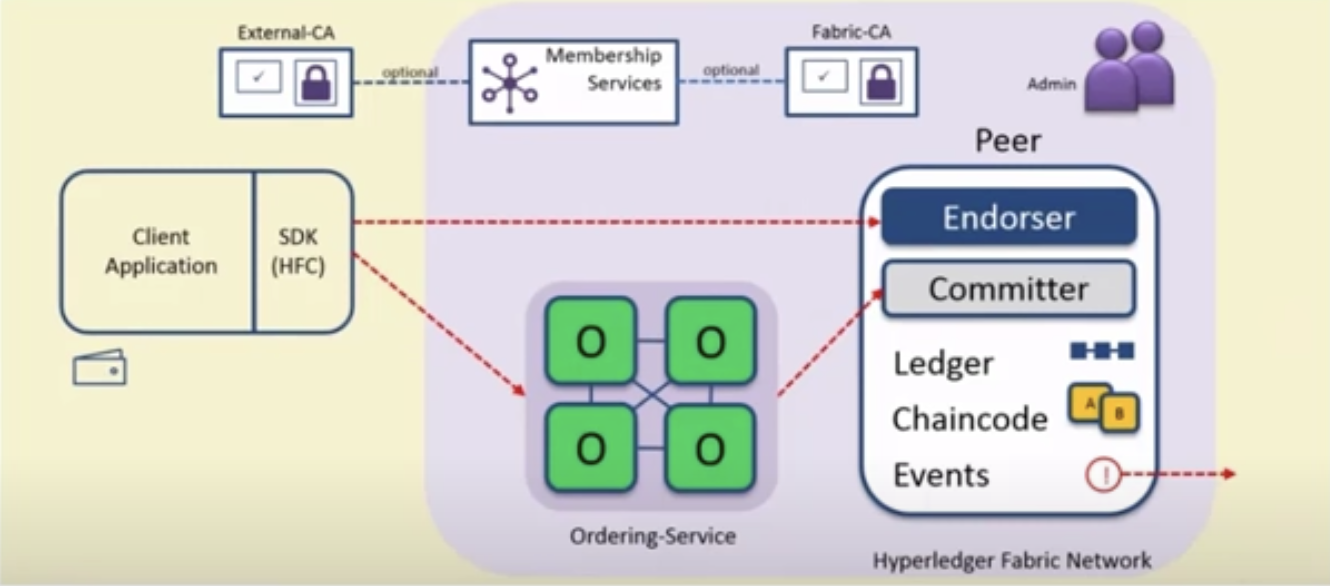"HyperLedger Fabric" in 2023: !(Part 1)
 Sukirat Warring
Sukirat WarringShort and crisp gist of hyper ledger Fabric's architecture plus the transaction flow.

Introduction
Hyperledger Fabric is an open-source blockchain framework tailored for enterprise applications. With a modular and flexible architecture, Fabric enables organizations to build and deploy secure, scalable, and permissioned blockchain networks. It prioritizes privacy and confidentiality, allowing authorized participants to transact and share information while maintaining control over data visibility. Fabric's unique consensus model allows organizations to choose the most suitable algorithm for their network, ensuring consensus integrity. Peers maintain the ledger, execute smart contracts (chain code), and validate transactions, while the ordering service establishes transaction order and creates blocks for commit. Fabric provides a rich set of features, making it an ideal choice for developing enterprise-grade blockchain solutions that address complex business requirements.
All the "heavy" words.
Peer:- In Hyperledger Fabric, peers are nodes that maintain a distributed ledger and participate in the consensus process for validating and committing transactions. Peers store a copy of the ledger and execute chain code (smart contracts) to process transactions.
Endorser:- These peers receive transaction proposals, simulate the execution of the proposed transactions, and endorse the results by signing the transaction. Endorsing peers are responsible for executing the chain code and verifying its correctness.
Committer:- In Hyperledger Fabric, a committer is a participant in the blockchain network who is responsible for committing transactions to the ledger. The committer's role is to receive ordered and validated blocks of transactions from the ordering service and then update the ledger state accordingly.
Membership Services:- Membership Services refer to the components and protocols that facilitate the management of participants (organizations and users) in a blockchain network. These services provide identity management, authentication, and access control mechanisms to ensure secure and authorized participation in the network.
Ordering Peers:- These peers receive endorsed transactions from endorsing peers, order them into a total order and create a block. Ordering peers are responsible for ensuring that the transactions are ordered consistently across the network.
Chaincode:- In Hyperledger Fabric, chain code is a term used to refer to smart contracts or the business logic that governs the behaviour of the blockchain network. Chaincode defines the rules for how transactions are processed and how the ledger state is updated.
Events:- Events are a mechanism used to facilitate communication and data sharing between different components of the blockchain network. Events allow participants to be notified of specific occurrences or changes happening within the network, enabling real-time updates and triggering actions based on predefined conditions.
Ledger:- Every peer in Hyperledger Fabric is responsible for maintaining and administering its ledger. The ledger consists of two main components: the blockchain and the world state. The blockchain is formed by a sequence of blocks, each containing a set of transactions. The creation of blocks is facilitated by an orderer.
Transaction Flow
HFC(Hyperledger Fabric Client):- Initially the client application sends a proposal to the chosen peer(s). This is the first step in the network.
Endorser:- After the transaction is sent to the endorser, now it is the job of the endorser to execute the transaction with the help of the chain code and then make the decision of either signing or rejecting it.
Back to the client:- The response from the endorser is sent back to the client
Ordering Services:- If the client receives a positive response then the client sends the transaction to the ordering service. Now, the ordering service appends this transaction to form a block.
Deliver Transaction:- Now, the created block is sent to the committer node
Validate Transaction:- Upon receiving a new block, each peer commits the block individually. That is, each peer validates the block and transactions and updates the ledger.
Conclusion
Hyperledger Fabric is an open-source blockchain framework designed for enterprise applications. It offers a flexible architecture, prioritizing privacy and scalability. Peers maintain the ledger, execute smart contracts, and validate transactions. Membership services manage participants and ensure secure participation. Ordering peers create blocks with endorsed transactions, maintaining consistent transaction ordering. Chaincode governs the network's behaviour. Events enable real-time updates and trigger actions. The ledger consists of a blockchain and a world state. Transaction flow involves client proposals, endorsement, ordering, and commit processes. Fabric is ideal for developing enterprise-grade blockchain solutions, and addressing complex business requirements. Its features empower organizations to build secure, scalable, and permissioned blockchain networks.
Subscribe to my newsletter
Read articles from Sukirat Warring directly inside your inbox. Subscribe to the newsletter, and don't miss out.
Written by
